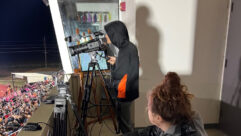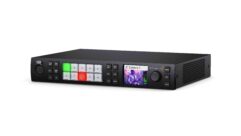
Expert Viewpoint: HD Antennas
Aug 1, 2008 12:00 PM,
By Kent Martin
Rabbit ears are back for the digital generation.
Sidebar

Antennas today come in an increasingly wide variety
of shapes and sizes. Antennas Direct makes this antenna disguised as a picture frame, which captures signals from up to 15 miles away and holds one 8”x10” photo.
At Fry’s Electronics in Manhattan Beach, Calif., the fact that an old technology is new again isn’t lost on one salesman.
“High-definition antennas are really growing in popularity,” he says, referencing the major reason behind the boom in HDTV antennas: next year’s nationwide conversion to digital signals. “Oh definitely,” the salesman, who preferred not to be identified, says. “People are preparing themselves for the change, and an HD antenna makes a lot of sense to them.”
Yes, this is the TV antenna we’re talking about — rabbit ears. Sometimes it consists of a coat hanger that has been bent and shaped to pull down whatever over-the-air signals are available. It’s the same technology that has remained, until recently, virtually unchanged over the last 50 years. One manufacturer flatly declares that the TV antennas sold today at electronics shops nationwide are technologically the same as antennas our grandparents purchased for their old black-and-white sets in the 1950s. Simply put, the technological design that was used by families decades ago to watch first-run episodes of I Love Lucy and Your Show of Shows is used today to watch CSI and Law & Order.
But all of this is changing. While the industry is focusing intently on bringing high-definition TV signals into homes across the country, not even the lowly rabbit ears have escaped evolution.
The advent of high-definition TV and the pending government-mandated conversion of broadcast signals from analog to digital in February 2009 have been accompanied by the usual technological accessories to enable viewers to receive the digital signals. The government is providing $40 coupons for converter boxes to help viewers make the change to HD. Electronics manufacturers are rolling out a wide array of gadgets designed to enhance the HD viewing experience.
And then there’s the antenna. The growth in popularity of the lowly antenna as an HD receiver has been somewhat of a surprise. Part of this comes from the fact that until recent advances in the design of the antenna, this technology has been viewed as more low-tech than high-tech.
In fact, there are those who believe the antenna can actually bring in high-definition signals better than either cable or satellite. The advantage is found in the antenna structure itself. Whereas cable and satellite transmissions must be compressed in order to be sent from the original transmitter to the receiver, an HD antenna simply grabs the over-the-air signal and hauls it into a TV set, absent the compression. The result is a clean, crisp picture straight from the transmitter. Furthermore, the HD antenna can be mounted outside or inside, depending on the model.
Expert Viewpoint: HD Antennas
Aug 1, 2008 12:00 PM,
By Kent Martin
Rabbit ears are back for the digital generation.

The Antennas Direct Lacrosse antenna has a range of 40 miles, and it is available in both amplified and non-amplified versions.
What has helped drive sales for HD antennas has been what one manufacturer calls a perfect storm.
“The government’s mandate for digital upgrades combined with the public’s interest in finding a good, quality way to watch HD television have made buyers keenly aware of their choices when shopping,” says Richard Schneider, president of Antennas Direct.
Apparently, the industry has done an outstanding job of educating and marketing HD antennas to consumers. Joshua Reyes, a salesman for leading online electronics retailer Smarthome, declares without hesitation that HD antennas are “selling like hotcakes.”
“The antenna industry has done a good job of making people think antennas are necessary to be able to capture digital signals,” Reyes says. “I would guess that 99 percent of our customers think that antennas are the only way they’ll be able to receive digital signals when the conversion occurs next year.”
The interpretation is erroneous, of course, but it does point to the success of the marketing campaign for the new antennas.
But the impact of the digital conversion will be a sea change for viewers nationwide. Industry analysts estimate there are perhaps 10 million households with HD television sets, but only a modest percentage of them use antennas.
In reality, some view the term “HD antenna” as a misnomer. The fact is: No antenna can distinguish between digital signals and analog signals. An HD antenna can still pick up analog signals along with digital signals, but the new generation of antennas is stronger and designed to pull in all over-the-air signals better and with greater reliability than previous models. The new models all but eliminate the fuzz and snow associated with analog models. Instead, an HD antenna either picks up the digital signal or it doesn’t.
The greatest appeal of these new antennas is the fact that they offer a superior picture and better service at a cheaper price than their cable and satellite counterparts. Officials with cable companies and satellite companies such as DirecTV would disagree, but hardcore TV viewers have pledged allegiance to their antennas. Remember that the picture captured by an antenna is virtually uncompressed compared with cable and satellite, which must compress their signals from the source in order to transmit all of the numerous channels they provide to subscribers. The only cost incurred is the purchase price of the antenna itself and installation, if assistance is needed. Antennas, of course, are unable to pick up cable or satellite channels such as HBO, ESPN, or Showtime — which is probably the biggest advantage cable and satellite systems offer over antennas.
These days, antennas come in an increasingly wide variety of sizes and shapes. Antennas Direct even sells one that is disguised as a handsome wooden picture frame and can receive signals from up to 15 miles away.
For Richard Schneider, necessity was definitely the mother of his invention when he grew frustrated with the available antennas on the market.
“I had become disenchanted with the reception I received in HD from cable and satellite,” Schneider says. “That’s when I started trying out my antenna. I figured the over-the-air signal should be clearer, since it’s not compressed like it is over cable or satellites.”
Schneider began by pulling apart a legacy antenna and learning why older models were unable to deliver signals with the quality he found in cable and satellite systems.
“Basically, legacy antennas were simply overwhelmed by all of the over-the-air transmissions that are prevalent today, such as cellular phone towers and FM-radio transmitters,” he says. “Out-of-band transmitters were wreaking havoc on the old legacy models.”
Schneider then began designing an antenna that was stronger and more reliable than old models. He sold the first models out of the back of his truck before he expanded into a warehouse in suburban Eureka, Mo., just outside of St. Louis.
“At first, we ran into a wave of skepticism among consumers,” Schneider says.
He launched a series of campaigns that featured giveaways around the Super Bowl in 2007 and other incentives for consumers to try out his antennas. The Super Bowl was a particular coup for Antennas Direct: A feud between cable giant Charter Communications and Belo Corporation — owner of TV stations in several major markets, including Schneider’s home base in St. Louis — had effectively blocked thousands of cable subscribers from watching the game in HD. When Schneider announced he was giving away his antennas before the Super Bowl, the response was quick and immediate: Lines of football fanatics stretched around the block of the retail outlet where Schneider was hosting his promotion.
Now, sales are responding to his marketing efforts, and Schneider says his sales have doubled annually since he started his company in 2003. Schneider has focused his attention on developing a new line of antennas that are smaller, more compact, and more powerful than previous lines. The picture-frame model he sells, for example, captures signals for up to 15 miles away, which makes it an ideal option for the homeowner who lives relatively near transmitting towers. Realizing the appeal of antennas that tend to blend in with a home’s furnishings, Schneider and his team are investing in other designs that deliver the same reliability and strength as larger models, yet don’t necessarily look out of place, say, in a bookshelf or on an end table.
For homeowners who live in more rural, remote areas, more powerful antennas that are mounted outdoors — typically on the roof — are the answer. These can be trickier to install, so assistance from local service shops may be needed. Plus, outdoor antennas are more subject to environmental conditions than indoor antennas.
“We actually invested in a military air simulator to enable us to research the capabilities of an outdoor antenna more quickly than we were before,” Schneider says. “Whereas it used to require maybe six to seven years of testing with an outdoor-mounted antenna, the military simulators give us the same results in six to seven months.”
The Consumer Electronics Association has created a website called antennaweb.org that helps consumers determine how far away they live from broadcast towers and recommends what type of antenna they should consider purchasing. The site also explains the differences among antennas — from small, directional models to larger, multidirectional antennas. Here again, the location of the home determines which antenna is best suited for viewing purposes.
Ultimately, the homeowner will have to decide how important it is to enjoy digital TV in all of its flavors. For those who simply want their local channels, the antenna offers perhaps the best and most affordable option. Others, however, may select the best of both worlds by combining an HD antenna with a cable or satellite system to be able to watch everything available on TV today.
Kent Martin is an award-winning journalist and freelance writer who covers a wide range of industries, including electronics and telecommunications.
Expert Viewpoint: HD Antennas
Aug 1, 2008 12:00 PM,
By Kent Martin
Rabbit ears are back for the digital generation.
How to Choose an HD Antenna
Although a common adage in almost any business is, “You get what you pay for,” average prices on HD antennas won’t break your budget. Plus, they pull down signals from HD transmitters for free, so when you calculate the cost of the antenna and subtract any cable or satellite fees you’d normally have to pay, antennas tend to pay for themselves.
Several things to look for when shopping for an antenna include:
- Check your current TV setup by attaching an antenna to your set. There’s a chance the antenna will do the job just fine and the converter box may not be what you need to pick up HD signals over the air.
- Try out your set now, before the rush hits closer to the February 2009 deadline for the conversion. Remember, too, that if you need to mount an outside antenna, it’s easier while the weather is warm than in the middle of winter.
- Watch which signals and stations you pick up with your antenna. Upgrade to a larger and more powerful model if you can’t bring in all of the stations you want at the level of quality you’re seeking.
- For a strong signal, you should only need a basic outdoor antenna to pick up VHF and UHF signals. Otherwise, consider installing a stronger antenna that is omni-directional or a motorized one that points toward each broadcast transmitter.
It may take a few tries to find the antenna that’s right for you. Prices can range from $10 to more than a $100 and installation (particularly for roof-mounted models) can cost extra.









